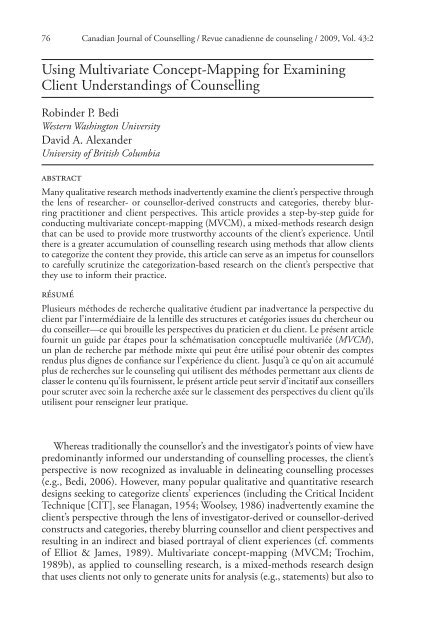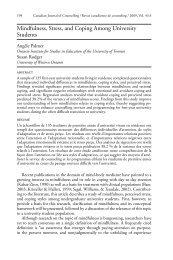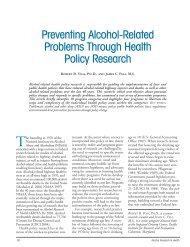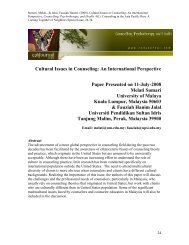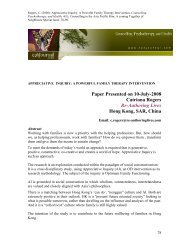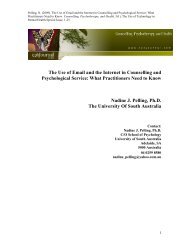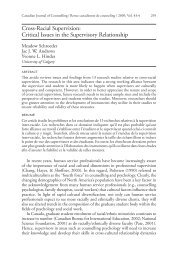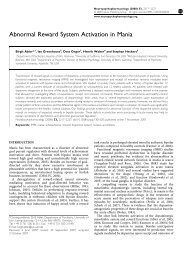View - Canadian Journal of Counselling and Psychotherapy / Revue ...
View - Canadian Journal of Counselling and Psychotherapy / Revue ...
View - Canadian Journal of Counselling and Psychotherapy / Revue ...
- No tags were found...
You also want an ePaper? Increase the reach of your titles
YUMPU automatically turns print PDFs into web optimized ePapers that Google loves.
76 <strong>Canadian</strong> <strong>Journal</strong> <strong>of</strong> <strong>Counselling</strong> / <strong>Revue</strong> canadienne de counseling / 2009, Vol. 43:2Using Multivariate Concept-Mapping for ExaminingClient Underst<strong>and</strong>ings <strong>of</strong> <strong>Counselling</strong>Robinder P. BediWestern Washington UniversityDavid A. Alex<strong>and</strong>erUniversity <strong>of</strong> British ColumbiaabstractMany qualitative research methods inadvertently examine the client’s perspective throughthe lens <strong>of</strong> researcher- or counsellor-derived constructs <strong>and</strong> categories, thereby blurringpractitioner <strong>and</strong> client perspectives. This article provides a step-by-step guide forconducting multivariate concept-mapping (MVCM), a mixed-methods research designthat can be used to provide more trustworthy accounts <strong>of</strong> the client’s experience. Untilthere is a greater accumulation <strong>of</strong> counselling research using methods that allow clientsto categorize the content they provide, this article can serve as an impetus for counsellorsto carefully scrutinize the categorization-based research on the client’s perspective thatthey use to inform their practice.résuméPlusieurs méthodes de recherche qualitative étudient par inadvertance la perspective duclient par l’intermédiaire de la lentille des structures et catégories issues du chercheur oudu conseiller—ce qui brouille les perspectives du praticien et du client. Le présent articlefournit un guide par étapes pour la schématisation conceptuelle multivariée (MVCM),un plan de recherche par méthode mixte qui peut être utilisé pour obtenir des comptesrendus plus dignes de confiance sur l’expérience du client. Jusqu’à ce qu’on ait accumuléplus de recherches sur le counseling qui utilisent des méthodes permettant aux clients declasser le contenu qu’ils fournissent, le présent article peut servir d’incitatif aux conseillerspour scruter avec soin la recherche axée sur le classement des perspectives du client qu’ilsutilisent pour renseigner leur pratique.Whereas traditionally the counsellor’s <strong>and</strong> the investigator’s points <strong>of</strong> view havepredominantly informed our underst<strong>and</strong>ing <strong>of</strong> counselling processes, the client’sperspective is now recognized as invaluable in delineating counselling processes(e.g., Bedi, 2006). However, many popular qualitative <strong>and</strong> quantitative researchdesigns seeking to categorize clients’ experiences (including the Critical IncidentTechnique [CIT], see Flanagan, 1954; Woolsey, 1986) inadvertently examine theclient’s perspective through the lens <strong>of</strong> investigator-derived or counsellor-derivedconstructs <strong>and</strong> categories, thereby blurring counsellor <strong>and</strong> client perspectives <strong>and</strong>resulting in an indirect <strong>and</strong> biased portrayal <strong>of</strong> client experiences (cf. comments<strong>of</strong> Elliot & James, 1989). Multivariate concept-mapping (MVCM; Trochim,1989b), as applied to counselling research, is a mixed-methods research designthat uses clients not only to generate units for analysis (e.g., statements) but also to
Using Multivariate Concept-Mapping for Examining 77categorize them, thereby faithfully privileging the clients’ subjective experiencing<strong>of</strong> counselling processes. This article introduces MVCM as an exemplary analyticalmethod for underst<strong>and</strong>ing the client’s perspective on experiences in counselling<strong>and</strong> provides a step-by-step guide for conducting MVCM research on counsellingprocesses. An example applying this research method to underst<strong>and</strong>ing the client’sperspective on the counselling alliance is presented along with a comparison <strong>of</strong>MVCM to the CIT.Although the term concept-mapping encapsulates a number <strong>of</strong> different procedures,most <strong>of</strong> these methods are geared toward pictorially representing theconceptualization <strong>of</strong> single individuals <strong>and</strong> many <strong>of</strong> these methods do not employsophisticated quantitative or qualitative analyses (for more details see Jackson &Trochim, 2002; Trochim, 1989b). The type <strong>of</strong> concept-mapping under considerationhere refers to a mixed-method form <strong>of</strong> concept-mapping that can readily yieldthe collective underst<strong>and</strong>ing <strong>of</strong> a group <strong>of</strong> individuals (a sort <strong>of</strong> consensual truth) ina graphical format (Trochim, 1989a, 1989b). In synopsis, MVCM is a structuredresearch strategy that <strong>of</strong>ten involves eliciting participant statements relevant to aparticular topic (directly or through transcript <strong>and</strong> document analysis), havingparticipants sort these statements into groups based on conceptual similarity (orsome other operational definition <strong>of</strong> similarity), <strong>and</strong> statistically analyzing thissorting information using sequential continuous <strong>and</strong> categorical multivariatemethods (typically multidimensional scaling followed by cluster analysis).MVCM is gaining increased prominence in mental health research (see examplesin Johnsen, Biegel, & Shafran, 2000). A cursory description <strong>of</strong> several studiesthat have used MVCM in counselling process research, in particular, is providedbelow (presented in chronological order).1. Kunkel <strong>and</strong> Newsom (1996) examined clients’ presenting problems using asample <strong>of</strong> 36 proxy sorters to sort 70 statements (extracted from the intakeforms <strong>of</strong> 83 clients).2. Paulson, Truscott, <strong>and</strong> Stuart (1999) examined clients’ experiences <strong>of</strong> helpfulevents in counselling using a sample <strong>of</strong> 36 clients (19 <strong>of</strong> whom participatedin the sorting task) who generated 80 statements.3. Truscott, Paulson, <strong>and</strong> Everall (1999) examined clients’ accounts <strong>of</strong> unhelpfulevents in counselling using a sample <strong>of</strong> 35 former clients (19 <strong>of</strong> whomparticipated in the sorting task) who generated 36 statements.4. Paulson <strong>and</strong> Worth (2002) examined key therapeutic processes in overcomingsuicidal ideation <strong>and</strong> behaviours using a sample <strong>of</strong> 9 previously suicidalclients who generated 65 statements (a new sample <strong>of</strong> 35 previously suicidalclients was used in the sorting task).5. Bedi (2006) examined the client’s perspective on the formation <strong>of</strong> a counsellingalliance using a sample <strong>of</strong> 40 clients (31 <strong>of</strong> whom returned for thesorting task) who provided 74 common factors in alliance formation.MVCM can be ideal for investigating client experiences as self-understoodwhen the intent is to minimize the biasing effects <strong>of</strong> investigator- or counsellor-
78 Robinder P. Bedi <strong>and</strong> David A. Alex<strong>and</strong>erimposed connotations <strong>and</strong> underst<strong>and</strong>ings. Allowing participants to utilize theirown meaning systems for creating <strong>and</strong> organizing categories ensures that thedetermined categories better reflect their conceptual structure rather than theconceptual structure <strong>of</strong> investigators or counsellors. Participants’ labels are alsosolicited <strong>and</strong> used in naming categories, thereby also eliminating researcher orcounsellor labelling biases. In sum, categorization through MVCM should bemore convincing in representing participants’ experiences because the meaningstructures <strong>of</strong> investigators are needed neither for creating categories nor for namingthem. Thus, the underst<strong>and</strong>ing <strong>of</strong> the construct in question is largely groundedin participant comprehension. In addition, by employing human judgement<strong>and</strong> statistical analyses in concert, the categories in MVCM are more empiricallygrounded than many other categorization research methods.Critics <strong>of</strong> the method have noted that individual differences <strong>and</strong> subgroup differenceshave been obscured in MVCM analyses, as the ultimate aim is to developan averaged, aggregate underst<strong>and</strong>ing (Riger, 1999). However, newer methodologicaladvancements such as idiographic concept-mapping (e.g., Goodyear, Tracey,Claiborn, Lichtenberg, & Wampold, 2005), pattern-matching (e.g., Kane &Trochim, 2007), <strong>and</strong> individual sort-group correlations (e.g., Bedi, 2006) haveemerged to allow the assessment <strong>of</strong> the fit <strong>of</strong> the final categorical system for eachindividual or subgroup.conducting multivariate concept-mappingMVCM, as commonly practiced within the Trochim (1989b) model, adheres toseveral demarcated steps. These steps are (a) establishing the research specifications;(b) creating the units <strong>of</strong> analysis (usually in the form <strong>of</strong> participant statements);(c) structuring the statements into groups <strong>of</strong> conceptually similar statements; (d)rating the statements; (e) running two-dimensional, non-metric multidimensionalscaling (nMDS) on the group-sort data (to determine an aggregate underst<strong>and</strong>ing<strong>of</strong> the similarity between statements); (f) running hierarchical cluster analysis(hCA) on the nMDS coordinates (to decide on a final cluster solution); (g) creatingconcept maps; (h) labelling the clusters; (i) interpreting concept maps; <strong>and</strong>(j) utilizing the maps (cf. Campbell & Salem, 1999; Jackson & Trochim, 2002;Paulson et al., 1999; Trochim, 1989b; Trochim, Cook, & Setze, 1994). Participantscan be involved, to various degrees, in every step <strong>of</strong> the analysis to furtherpromote the claim that this primarily quantitative research method can be highlyclient-centred. These steps are further described below.Establishing the Research SpecificationsThe first step <strong>of</strong> MVCM requires a detailed outlining <strong>of</strong> the research study, itspurpose, <strong>and</strong> the parameters <strong>of</strong> the construct to be examined. This includes definingthe actual content domain as well as the means by which the statements willbe obtained <strong>and</strong> rated, by whom, by how many participants, <strong>and</strong> on what basis.
Using Multivariate Concept-Mapping for Examining 79The investigators must decide whose voices they wish to capture, <strong>and</strong> an appropriatesample must then be identified (Campbell & Salem, 1999). It hasbeen advocated that MVCM is at its best when it includes the perspective <strong>of</strong> awide variety <strong>of</strong> pertinent individuals. Doing so better ensures that a diversity <strong>of</strong>viewpoints are incorporated, which <strong>of</strong>ten results in a greater relevance <strong>of</strong> the finalresults for more individuals (Trochim, 1989b). In some contexts, it might bepossible to use r<strong>and</strong>om sampling techniques to select a representative sample <strong>of</strong>participants from a larger defined population (e.g., Campbell & Salem) in orderto allow for the less contestable generalization <strong>of</strong> the concept map to the largerpopulation. However, given that such a sampling method is <strong>of</strong>ten unfeasible,purposive sampling <strong>and</strong> generalization on the basis <strong>of</strong> similarities <strong>and</strong> differences(e.g., <strong>of</strong> sample characteristics or <strong>of</strong> environmental conditions), termed intuitiveor analytical generalizability (Stake, 1994), can also be done.There is no fixed upper or lower limit on the number <strong>of</strong> participants needed toimplement MVCM methods. The required number <strong>of</strong> participants depends on theconcept under study, with the goal being to thoroughly identify the essence <strong>and</strong>variety <strong>of</strong> participants’ experiences or underst<strong>and</strong>ings (Trochim, 1989b; Truscottet al., 1999). It seems intuitive that the more respondents used at each stage <strong>of</strong>the analysis, the better the resulting concept maps will represent the sample’s collectiveunderst<strong>and</strong>ing <strong>of</strong> the particular topic (Jackson & Trochim, 2002). Samplesizes as small as 10 to 20 have been found to be highly manageable (Trochim,1989b) <strong>and</strong> sample sizes <strong>of</strong> 20 to 30 have been consistently judged to providevalid results (Trochim, 1993).Sample size for category-creating research methods such as MVCM also refersto the number <strong>of</strong> statements collected. In order to ensure as complete coverage<strong>of</strong> the domain as possible, a loose guideline should be to collect until adequateredundancy <strong>of</strong> statements appears (cf. Flanagan, 1954; cf. Paulson et al., 1999).Creating the Units <strong>of</strong> AnalysisTo create the units <strong>of</strong> analysis, participants are asked to report ideas, thoughts,or experiences (<strong>of</strong>ten in the form <strong>of</strong> statements) in response to a specific question oran open-ended prompt reflecting the topic under consideration. There are severalways that statements can be obtained, including group brainstorming, individualinterviews, self-report questionnaires, <strong>and</strong> the extraction <strong>of</strong> statements from textdocuments (e.g., reports, memos, books, transcribed interviews, field notes).In counselling process research using MVCM, participants’ responses are typicallyaudio-recorded, transcribed, <strong>and</strong> then analyzed to obtain statements thatcapture the meaning <strong>of</strong> participant experiences (Paulson et al., 1999; Truscottet al., 1999). Such extractions can be made either individually or in groups <strong>and</strong>by either participants or researchers (Jackson & Trochim, 2002). An importantissue in extracting statements from text data is to retain the original language <strong>of</strong>participants’ responses as much as possible (Jackson & Trochim; Truscott et al.).Discussions with participants can also be held to reduce uncertainty about ambiguousextraction decisions made by investigators (Jackson & Trochim). Once the
80 Robinder P. Bedi <strong>and</strong> David A. Alex<strong>and</strong>erstatements have been generated or extracted, it is useful to edit the statements toeliminate awkward wordings, technical jargon, extraneous statements (e.g., dueto misunderst<strong>and</strong>ing the question), <strong>and</strong> statements <strong>of</strong> insufficient detail.Very large numbers <strong>of</strong> statements impose important practical <strong>and</strong> computationallimitations. To avoid participant fatigue, Trochim (1989b) recommendedlimiting the number <strong>of</strong> statements to 100 or fewer. If the initial set <strong>of</strong> statementsexceeds this number, there are several ways to reduce the set. For example, redundanciescan be eliminated (e.g., Paulson et al., 1999) or representative statementscan be chosen to reflect a larger subset <strong>of</strong> related statements (e.g., Campbell &Salem, 1999; Tracey, Lichtenberg, Goodyear, Claiborn, & Wampold, 2003). Oncethe needed reduction decisions are made, the final set <strong>of</strong> statements should bewritten on index cards in preparation for the next step.Structuring <strong>and</strong> Rating the StatementsParticipants usually judge the similarity <strong>of</strong> the statements through a card sort.Working individually, each participant organizes the statements into self-definedconceptually similar piles. Specifically, participants are asked to place the cards inpiles according to how they seem to go together in a way that makes sense to them.Although other methods are available to compute similarity information, such aspaired comparison ratings, correlations, measures <strong>of</strong> stimulus confusability, <strong>and</strong>interaction frequencies (Fitzgerald & Hubert, 1987), these become impracticalwith a large number <strong>of</strong> items (Shern, Trochim, & LaComb, 1995). The strength<strong>of</strong> sorting to judge similarity is its time <strong>and</strong> labour efficiency.A few restrictions can be placed on participants’ sorting strategies to ensurethe subsequent statistical analyses are optimized (cf. Campbell & Salem, 1999;Trochim et al., 1994; Truscott et al., 1999), or participants can be given free reinon the sorting activity (e.g., Goodyear et al., 2005). Nevertheless, each sorter selfdetermineshow many categories to create, what each category should contain,<strong>and</strong> what each one should be named.It has been recommended that at least 20 participants engage in the sorting task(Paulson et al., 1999), although valid results have been obtained with as few as 10participants (Trochim, 1989a, 1989b). It is also recommended that the participantswho generated the statements do the sorting. Because this is not always practical,proxy sorters can be carefully chosen (for guidelines see Jackson & Trochim, 2002),although their use can draw the validity <strong>and</strong> generalizability <strong>of</strong> the results intosome question. During the rating step, participants appraise each statement on aLikert-type rating scale reflecting some important dimension (e.g., importance,significance, strength). Descriptive statistics are then calculated on these ratings.Running Non-Metric Multidimensional Scaling on the Group-Sort DataDuring this step, the statistical technique <strong>of</strong> unweighted two-dimensionalnMDS is typically performed on the data reflecting the sorted statements to suggestthe aggregate, organizational principles inherent in the sorting. The ConceptSystem computer s<strong>of</strong>tware, currently at version 4.0 (Concept Systems Inc., 2008),
Using Multivariate Concept-Mapping for Examining 81automatically reformats the data into the matrix format needed for MVCM, butfor those wishing to use other statistical packages, the details <strong>of</strong> matrix set-up areprovided in Bedi (2006). Unweighted nMDS is a statistical technique that takessome measure <strong>of</strong> similarity (e.g., frequency with which items were grouped togetherin the same pile across participants) <strong>and</strong> plots items such that the distancebetween points indicates their similarity. In other words, statements that appearcloser to each other on the concept map were sorted together more frequently(Johnsen et al., 2000). The exact position <strong>of</strong> each point on the map (e.g., top,bottom, right, left) is not as important as the distance between the points.When conducting nMD, one has to specify how many dimensions the set <strong>of</strong>points is to be fit to. The issue <strong>of</strong> dimensionality in nMDS has been well discussedin the literature (Jackson <strong>and</strong> Trochim, 2002; Trochim, 1989b). A popular viewsuggests that the selection <strong>of</strong> a two-dimensional solution for MVCM is appropriategiven that the primary purpose <strong>of</strong> the nMDS configuration is to display clusteringresults visually, which is difficult to do in three or more dimensions (e.g., Fitzgerald& Hubert, 1987; Kruskal & Wish, 1978). This latter conclusion is consistentwith the viewpoint <strong>of</strong> Trochim (1989b). He found that two‐dimensional solutionshave almost always been acceptable as long as they have been coupled with clusteranalysis. Therefore, in terms <strong>of</strong> dimensionality, MVCM typically works in twodimensionalspace (Jackson & Trochim). A statistic termed a stress value can beused to judge the adequacy <strong>of</strong> a two-dimensional solution. The stress value is anoverall index <strong>of</strong> the stability <strong>of</strong> the nMDS solution <strong>and</strong> ranges from zero (perfectlystable) to one (perfectly unstable). More specifically, stress represents the extent towhich the created nMDS pattern <strong>of</strong> similarities matches the observed similarities(i.e., the extent to which the similarity data can be translated into correspondingtwo-dimensional distance data). According to Trochim (1989b), a rule <strong>of</strong> thumbwhen working with complex psychological phenomena is that a stress value <strong>of</strong> lessthan .30 represents a stable nMDS solution whereas a value over .40 indicates thatdata were not consistently sorted in any clear, thematic way.Running Hierarchical Cluster Analysis on the nMDS CoordinatesDuring this step, agglomerative hCA is applied to the coordinate data derivedfrom nMDS to identify conceptually similar groups <strong>of</strong> sorted items. According toAfifi <strong>and</strong> Clark (1996), this type <strong>of</strong> cluster analysis is most helpful in identifyingcategories when the structure <strong>of</strong> categories is not already known.Specifically, hCA partitions the point map developed by nMDS into nonoverlappingclusters <strong>of</strong> related statements <strong>and</strong> superimposes this cluster solutiononto the two-dimensional nMDS plot. The cluster boundaries around groups<strong>of</strong> points represent statements that were more frequently sorted together in thesame pile <strong>and</strong> less <strong>of</strong>ten sorted with statements in other piles. The key task is todecide how many clusters the statements should be grouped into for the acceptedsolution (Johnsen et al., 2000). A few heuristics guide the researcher. First, assuggested by Trochim (1989b), all cluster solutions from about 20 to 3 clustersshould be examined in an attempt to decide whether a particular grouping or
82 Robinder P. Bedi <strong>and</strong> David A. Alex<strong>and</strong>ercombination <strong>of</strong> clusters makes conceptual <strong>and</strong> interpretive sense (see also Johnsenet al.). Second, bridging values can assist in selecting a cluster solution (Jackson& Trochim, 2002). A bridging value ranges from zero to one <strong>and</strong> mathematicallyindexes how <strong>of</strong>ten a statement was sorted with others that are close to it on themap compared to those statements further away (Concept Systems Inc., 2008).Lower bridging values indicate a closer relationship with other statements in thecluster (<strong>and</strong> a “good” categorization solution will have many low cluster bridgingvalues). Third, selecting a cluster solution close to the average number <strong>of</strong> piles usedby participants to categorize the statements lends further credence to the claimthat the final classification scheme represents a typical client experience.Creating Concept MapsOnce we have conducted nMDS <strong>and</strong> hCA, the results are represented in graphicalform by way <strong>of</strong> several types <strong>of</strong> concept maps (Concept Systems Inc., 2008;Trochim, 1989a, 1989b), some <strong>of</strong> which are1. A statement map (see Figure 1) locates each <strong>of</strong> the statements as a bivariatepoint (based on two-dimensional nMDS). Distance between points reflectsthe extent to which statements were sorted together <strong>and</strong> thus is an indicator<strong>of</strong> conceptual similarity.2. A cluster map (see Figure 2) shows how statements can be grouped intoclusters according to conceptual similarity (i.e., displays the results <strong>of</strong> hCA).3. A cluster rating map (see Figure 3) shows the average rating <strong>of</strong> statementsincluded within each cluster. Height represents higher average ratings.4. A cluster bridging map (see Figure 4) shows the average bridging values(reflecting homogeneity) <strong>of</strong> each cluster. A higher cluster height indicates ahigher average bridging value.Labelling the ClustersEach cluster is given a name that is deemed to best describe the set <strong>of</strong> statementsin that cluster; participants can be included in naming the final categories.The participant-generated title that falls closest to the centroid <strong>of</strong> the final plottedcluster (i.e., the single participant’s category label that best matches the final groupcluster/category) can also be used to name categories in the participant’s ownwords, as is done in the Concept System s<strong>of</strong>tware (Concept Systems Inc., 2008).Interpreting Concept MapsMany avenues <strong>of</strong> interpretation can be gleaned from the above discussion. Forexample, statements within clusters are considered conceptually homogeneous tovarying degrees, points or clusters that fall closer together are more conceptuallyrelated, <strong>and</strong> the height <strong>of</strong> clusters represents their importance or bridging. Giventhat the concept map is a map, interpretation can involve taking a geographic“trip” across the map, paying particular attention to spatial relationships betweenthe clusters <strong>and</strong>/or individual statements. Participants should subsequently ex-
Using Multivariate Concept-Mapping for Examining 83amine the resultant concept maps <strong>and</strong> judge whether they correspond to theirunderst<strong>and</strong>ings or, at least, seem reasonable to them (for an example <strong>of</strong> how thiscan be done systematically, see Bedi, 2006).In providing an interpretation <strong>of</strong> a concept map, it is important to enquireabout the degree to which concept maps are reliable <strong>and</strong> valid. No single, infal-Figure 1Statement mapFigure 2Cluster map
84 Robinder P. Bedi <strong>and</strong> David A. Alex<strong>and</strong>erlible estimate <strong>of</strong> either reliability or validity for this multistep complex processis available (Trochim et al., 1994). As noted by Jackson <strong>and</strong> Trochim (2002),each step <strong>of</strong> MVCM has reliability <strong>and</strong> validity implications. Decisions made atFigure 3Cluster rating mapFigure 4Cluster bridging map
Using Multivariate Concept-Mapping for Examining 85each stage (e.g., the decision to use original or proxy sorters) can either increaseor decrease how representative the obtained results are. Some indications <strong>of</strong> theprocedural validity <strong>of</strong> MVCM in representing participant accounts have alreadybeen noted when discussing the advantages <strong>and</strong> strengths <strong>of</strong> MVCM, <strong>and</strong> primarilyrelate to the high degree to which it is a participant-driven method. Forthe sake <strong>of</strong> simplicity, reliability in MVCM can be understood as the degree towhich parts <strong>of</strong> the process (e.g., statement generation, sorting, ratings, clusterlabelling, concept maps) are repeatable <strong>and</strong> validity as the degree to which parts<strong>of</strong> the process can be reasonably judged to reflect some underlying <strong>and</strong> locallyconstructed “reality” (cf. Trochim, 1989b). A summary <strong>of</strong> reliability <strong>and</strong> validitymeasures is presented in Trochim (1993) <strong>and</strong> exemplified in Bedi (2006). Somemethods include individual sort-group sort correlations <strong>and</strong> split-half reliabilityanalyses.Utilizing Concept MapsDuring this step, the concept maps are used for the overall purpose set out inStep 1. In counselling research this can be, for example, stimulating additionalresearch on newly identified variables, forming theory or a model, testing theory,creating a training regimen, developing a counselling program, or evaluating acounselling program.concept-mapping computer analysesIn conducting MVCM, two options exist for the computer analyses <strong>and</strong> graphicalpresentation <strong>of</strong> the results. In using general-purpose s<strong>of</strong>tware, a statistics programthat provides nMDS <strong>and</strong> hCA (with flexible data-manipulation capabilities)<strong>and</strong> a sophisticated graphics program are required (Trochim, 1989b). However,there are some data entry <strong>and</strong> data analysis complexities, such as the likely needto construct <strong>and</strong> import data in matrix format <strong>and</strong> the need to use computerprogramming syntax language for some analyses (see comments <strong>of</strong> Trochim,1989b). Alternatively, the Concept System computer s<strong>of</strong>tware (Concept SystemsInc., 2008) combines word processing, statistical, <strong>and</strong> graphical capabilities usingthe appropriate statistical algorithms, <strong>and</strong> allows for user-friendly completion <strong>of</strong>concept mapping analyses.an example <strong>of</strong> mvcm in counselling researchThe following represents the preliminary report, using simplified analyses, <strong>of</strong>Bedi (2006), 1 presented here to exemplify the method in the context <strong>of</strong> an actualresearch question <strong>and</strong> not for the purposes <strong>of</strong> putting forth content knowledgeabout the counselling alliance. The reader is referred to Bedi to better underst<strong>and</strong>the client’s perspective on counselling alliance formation.Forty participants were interviewed about their experiences in counselling.Important counselling alliance formation factors (in the form <strong>of</strong> participant state-
86 Robinder P. Bedi <strong>and</strong> David A. Alex<strong>and</strong>erments about critical incidents involved in the formation <strong>of</strong> their own counsellingalliance) were then documented from their accounts. Thirty-one participants thenreturned <strong>and</strong> sorted the 74 most common statements into self-defined conceptuallymeaningful categories. MVCM statistical techniques were used to compute the“average” multivariate sort across the participants. This represents the most typicalconceptual structure used by participants on helpful factors in establishing a positivecounselling alliance. After completion <strong>of</strong> the sorting task, participants weregiven a questionnaire <strong>and</strong> asked to rate the relative importance <strong>of</strong> each statementfor establishing a “good working relationship” between them <strong>and</strong> their counselloron a 5-point Likert-type scale.Based on the statement map (Figure 1), we can decipher which statements arerelated to which others. Three statements are highlighted to exemplify that statementsfalling closer together are conceptually more similar than statements fallingfurther apart. As can be seen in the Cluster Map (Figure 2), factors importantin alliance formation can be classified into 13 categories based on basic MVCManalyses: Office Environment, First Impressions, Body Language, ListeningSkills, Unconditional Positive Regard, Encouragement, Challenging, Ethics <strong>and</strong>Boundaries, Education, Referrals <strong>and</strong> Recommended Materials, Client Commitment,Procedural Clarifications, <strong>and</strong> Choosing a Counsellor. The cluster ratingmap (Figure 3) indicates which categories <strong>of</strong> alliance formation factors were ratedas more <strong>and</strong> less important by clients (e.g., Choosing a Counsellor [#8], First Impressions[#5], <strong>and</strong> Office Environment [#4] are rated as relatively less important,while Education [#11], Counsellor Body Language [#3], Procedural Clarifications[#6], Challenging [#10], <strong>and</strong> Listening Skills [#1] are rated as relatively moreimportant). The cluster bridging map (Figure 4) indicates which categories aremost homogeneous with respect to how items within them were sorted with otherstatements (for example, the items composing Challenging [#10] were usuallysorted together rather than with other statements; conversely, the items composingClient Commitment [#7] were <strong>of</strong>ten sorted with items belonging to otherclusters, implying that clients underst<strong>and</strong> the concept <strong>of</strong> Client Commitmentquite differently from each other).comparing mvcm with the critical incident techniqueTo help clarify the distinctness <strong>and</strong> benefits <strong>of</strong> MVCM, it would be useful tocompare <strong>and</strong> contrast it to a more established research method. The CIT is selectedfor this purpose because (a) it is a popular method amongst <strong>Canadian</strong> counsellingresearchers, (b) it has a reasonable rate <strong>of</strong> use in empirical articles publishedin the <strong>Canadian</strong> <strong>Journal</strong> <strong>of</strong> <strong>Counselling</strong> <strong>and</strong> thus should be fairly familiar to theinternational readership <strong>of</strong> this journal, (c) its results can be questioned as to theextent that the emergent categories represent client underst<strong>and</strong>ings in a trustworthymanner, <strong>and</strong> (d) it can be viably integrated with MVCM.It has been just over 20 years since Woolsey (1986) published an article in the<strong>Canadian</strong> <strong>Journal</strong> <strong>of</strong> <strong>Counselling</strong> promoting the benefits <strong>of</strong> using the CIT (Flana-
Using Multivariate Concept-Mapping for Examining 87gan, 1954) for <strong>Canadian</strong> counselling research. Since that time, the method hasbecome much more popular amongst counselling students, counselling researchers,<strong>and</strong> counsellor educators (for a detailed account see Butterfield, Borgen,Amundson, & Maglio, 2005). For example, within a roughly 12-year periodfrom 1991 to 2003, an average <strong>of</strong> almost two theses or dissertations per year atthe University <strong>of</strong> British Columbia’s counselling psychology program used theCIT research method. Moreover, several <strong>Canadian</strong> <strong>Journal</strong> <strong>of</strong> <strong>Counselling</strong> articleshave used this method to inform counsellors <strong>and</strong> counsellor educators. Forexample, the CIT has been used to explore barriers <strong>and</strong> facilitators <strong>of</strong> reflectivepractice in counsellor education (Wong-Wylie, 2007), the client’s perspectiveon counselling alliance formation (Bedi, Davis, & Arvay, 2005), First Nationshealing practices (McCormick, 1997), the use <strong>of</strong> family systems approaches byschool counsellors (Sawatzky, Eckert, & Ryan, 1993), <strong>and</strong> school counsellors’perceptions <strong>of</strong> their effectiveness (Gora, Sawatzky, & Hague, 1992). Clearly, <strong>and</strong>partly owing to its description in the <strong>Canadian</strong> <strong>Journal</strong> <strong>of</strong> <strong>Counselling</strong>, the CIT isfamiliar to many <strong>Canadian</strong> <strong>and</strong> international counsellors <strong>and</strong> counsellor educators<strong>and</strong> many <strong>of</strong> them have read research that employed this method to informtheir practice.Both MVCM <strong>and</strong> the CIT are categorization-based research methods thatemerged out <strong>of</strong> post-positivistic thinking but have been adapted to constructivist/constructionistthought (cf. Butterfield et al., 2005; Bedi, 2006). Both canalso be placed somewhere in the middle <strong>of</strong> the qualitative-quantitative researchcontinuum as they both contains elements <strong>of</strong> each. These two research methodsalso share the use <strong>of</strong> verbatim client/participant statements as the original units <strong>of</strong>analysis. However, the CIT uses researchers or counsellors to impose a conceptualstructure on the client/participant-elicited statements, <strong>and</strong> the bias introducedby using researcher- or counsellor-generated coding systems to characterize clientexperience should be apparent. As such, counsellors should carefully scrutinizeCIT research that purports to represent the client’s perspective in light <strong>of</strong> suchpotential influence before allowing it to inform their practice.Different Results from the Critical Incident TechniqueAlthough not exactly comparable, a comparison <strong>of</strong> the above MVCM examplewith the CIT results <strong>of</strong> Bedi, Davis, <strong>and</strong> Williams (2005) can further help counsellorsunderst<strong>and</strong> the differences that can result when relying on CIT research toinform their practice. In investigating the exact same research question <strong>and</strong> usingvirtually the same set <strong>of</strong> participants, 2 Bedi, Davis, <strong>and</strong> Williams used the CITto identify 196 non-repetitious critical incidents (CIs). Using two researchers/sorters <strong>and</strong> four validators, 25 consensual categories were created <strong>and</strong> validated.This st<strong>and</strong>s in stark contrast to the 13 categories used in the example to summarizecategories <strong>of</strong> client-identified factors in alliance formation, from the client’sperspective, when using clients as sorters.There are also some notable discrepancies in the words chosen by researchersor counsellors rather than by clients in labelling client experiences. Even when
88 Robinder P. Bedi <strong>and</strong> David A. Alex<strong>and</strong>eronly considering the 74 factors used in the example <strong>and</strong> mapping them onto thecategories presented in Bedi, Davis, <strong>and</strong> Williams (2005), 24 out <strong>of</strong> the 25 categorieswere still invoked. 3 These points imply that a discrepancy seems to existwhen counsellors or researchers categorize clients’ statements <strong>and</strong> purport to <strong>of</strong>fer arepresentation <strong>of</strong> the clients’ perspectives versus when the clients do so themselves.Perhaps counsellors <strong>and</strong> researchers are more reductionistic (because they createa larger number <strong>of</strong> categories to describe client experience) <strong>and</strong> perhaps they uselabels that are not in line with the ones that clients would use.Another comparison study is provided by Bedi, Davis, <strong>and</strong> Arvay (2005), whoalso used the CIT to investigate the same research question. With a sample <strong>of</strong> nineparticipants who provided 107 CIs, three researchers developed an eight-categorysystem with seven subcategories to summarize the clients’ perspectives in underst<strong>and</strong>ingalliance formation factors. The number <strong>of</strong> categories, the labels chosen,<strong>and</strong> the fact that a higher-order categorization system was developed divergesnotably from the 13 single-level categories found when using clients themselvesto do the sorting in the MVCM example.In sum, using researchers (even those trained in counselling) to impose structureon units <strong>of</strong> meaning provided by counselling clients in research (as is done with theCIT) can be questioned if the aim is to report client underst<strong>and</strong>ings. Counsellorswho rely on researcher-generated coding systems to inform their underst<strong>and</strong>ing<strong>of</strong> the clients’ perspectives should do so cautiously <strong>and</strong> be aware <strong>of</strong> the influence<strong>of</strong> non-client categorizers.Although the type <strong>of</strong> MVCM described here averages across participants tocome up with a single typical sort that best represents the clients’ perspectives,new methods have been developed to better account for individual differencesin the overall concept map <strong>and</strong> assess the extent to which the aggregate solutiondifferentially represents the underst<strong>and</strong>ing <strong>of</strong> each individual in the sample (seeBedi, 2006). In fact, Goodyear et al. (2005) use similar analytical strategies topresent an account <strong>of</strong> idiographic MVCM, in which a concept map model isprovided for each individual.Combining MVCM with the CITMVCM has traditionally lacked both the level <strong>of</strong> rigour typically involved inCIT data collection <strong>and</strong> also the output <strong>of</strong> concrete <strong>and</strong> behavioural-type information.As such, a mixed-methods approach capitalizing on the strengths <strong>of</strong> each tocounter the limitations <strong>of</strong> the other is a useful strategy for counselling researchersusing either method in isolation. Specifically, it would be beneficial to combinethe CIT data-collection procedures with the categorization <strong>and</strong> statistical analysistechniques <strong>of</strong> MVCM (e.g., Bedi, 2006; Stiles, 2007). Doing so permits us tointegrate human judgement in concert with statistical analyses <strong>and</strong> allows for theoutput <strong>of</strong> concrete <strong>and</strong> behavioural data in a manner that still honours participants’subjective underst<strong>and</strong>ings <strong>and</strong> conceptual structures. The intended flexibility <strong>of</strong>the CIT that justifies its combination with quantitative methods such as MVCMon both practical <strong>and</strong> philosophical grounds is discussed at length by Butterfield
Using Multivariate Concept-Mapping for Examining 89et al. (2005) <strong>and</strong> also exemplified by Silber et al. (2006; who combined the CITwith linear <strong>and</strong> logistic regression).conclusionMany qualitative <strong>and</strong> quantitative research designs requiring categorization <strong>of</strong>clients’ experiences (like the CIT) inadvertently examine the clients’ perspectivesthrough the lens <strong>of</strong> investigator-derived or counsellor-derived constructs <strong>and</strong> categories,thereby blurring counsellor <strong>and</strong> client perspectives. MVCM (especiallywhen combined with the CIT) is a suitable mixed-methods research design thatensures that the concluded client’s perspective is a more fitting representation <strong>of</strong>the client’s subjective experience <strong>of</strong> counselling processes. This article introducedMVCM as an exemplary analytical method for underst<strong>and</strong>ing clients’ perspectiveson their experiences in counselling <strong>and</strong> provided a step-by-step guide forcounselling researchers interested in conducting MVCM research. An example<strong>of</strong> applying this research method to underst<strong>and</strong>ing the client’s perspective oncounselling alliance formation was also provided to better exemplify the method.In the long term, it is hoped that this article will result in greater awareness <strong>of</strong>this research method amongst counsellor educators, counselling researchers, <strong>and</strong>students in Canada, with the result being a better overall underst<strong>and</strong>ing <strong>of</strong> clients’perspectives <strong>and</strong> experiences <strong>of</strong> counselling processes. This, in turn, will benefitcounselling practitioners who will be able to consult this literature to inform theirpractice. In the short term, it is hoped that counsellors will use the arguments <strong>and</strong>principles presented in this article to critically evaluate counselling research thatpurports to inform them about client perspectives. In addition, counsellor educatorsshould be careful when discussing research that uses researchers or counsellorsto categorize clients’ incidents as necessarily representing the phenomenologicalexperience <strong>of</strong> clients.AcknowledgementsPortions <strong>of</strong> this article were presented at the third Conry Conference on Measurement, Evaluation<strong>and</strong> Research Methodology in Vancouver, BC, Canada on February 13, 2004. This article was supportedin part by grants from the Michael Smith Foundation for Health Research, the Fahs-BeckFund for Research <strong>and</strong> Experimentation in collaboration with The New York Community Trust,<strong>and</strong> the Faculty <strong>of</strong> Education at the University <strong>of</strong> British Columbia.Notes1 Please note that this cluster solution privileged interpretability (but still considered the otherdecision-making heuristics) in illustrating a concept map. This justified the omission <strong>of</strong> thediscussion <strong>of</strong> other <strong>and</strong> more complex decision-making tools (several <strong>of</strong> which are highlyquantitative) <strong>and</strong> also permitted better comparison with the CIT, which also privileges interpretabilityin generating a categorization scheme. A more defensible cluster solution using additionalquantitative considerations is available in Bedi (2006).2 Bedi, Davis, <strong>and</strong> Williams (2005) used 40 participants, 31 <strong>of</strong> whom returned later to completethe sorting tasks <strong>of</strong> the subsequent MVCM study exemplified above.3 The only category in Bedi, Davis, <strong>and</strong> Williams (2005) not represented by the 74 factors in theexample MVCM study was External Contact.
90 Robinder P. Bedi <strong>and</strong> David A. Alex<strong>and</strong>erReferencesAfifi, A., & Clark, V. (1996). Computer-aided multivariate analysis (3rd ed.). Boca Raton, FL:Chapman & Hall/CRC.Bedi, R. P. (2006). Concept-mapping the client’s perspective on counseling alliance formation.<strong>Journal</strong> <strong>of</strong> Counseling Psychology, 53, 26–35.Bedi, R. P., Davis, M. D., & Arvay, M. A. (2005). The client’s perspective on counselling allianceformation <strong>and</strong> implications for research on counsellor training. <strong>Canadian</strong> <strong>Journal</strong> <strong>of</strong> <strong>Counselling</strong>,39, 71–85.Bedi, R. P., Davis, M. D., & Williams, M. (2005). Critical incidents in the formation <strong>of</strong> the therapeuticalliance from the client’s perspective. <strong>Psychotherapy</strong>: Theory, Research, Practice, Training,42, 311–323.Butterfield, L. D., Borgen, W. A., Amundson, N. E., & Maglio, A. T. (2005). Fifty years <strong>of</strong> theCritical Incident Technique: 1954–2004 <strong>and</strong> beyond. Qualitative Research, 5, 475–497.Campbell, R., & Salem, D. A. (1999). Concept mapping as a feminist research method: Examination<strong>of</strong> the community response to rape. Psychology <strong>of</strong> Women Quarterly, 23, 65–89.Concept Systems Inc. (2008). The concept system facilitator training seminar manual. Ithaca, NY:Author.Elliot, R. E., & James, E. (1989). Varieties <strong>of</strong> client experience in psychotherapy: An analysis <strong>of</strong>the literature. Clinical Psychology Review, 9, 443–467.Fitzgerald, L. F., & Hubert, L. J. (1987). Multidimensional scaling: Some possibilities for counsellingpsychology. <strong>Journal</strong> <strong>of</strong> Counseling Psychology, 34, 469–480.Flanagan, J. C. (1954). The critical incident technique. Psychological Bulletin, 51, 327–358.Goodyear, R. K., Tracey, T. J., Claiborn, C. D., Lichtenberg, J. W., & Wampold, B. E. (2005).Ideographic concept mapping in counselling psychology research: Conceptual overview, methodology,<strong>and</strong> an illustration. <strong>Journal</strong> <strong>of</strong> Counseling Psychology, 52, 236–242.Gora, R., Sawatzky, D., & Hague, W. (1992). School counsellors’ perceptions <strong>of</strong> their effectiveness.<strong>Canadian</strong> <strong>Journal</strong> <strong>of</strong> <strong>Counselling</strong>, 26, 5–14.Jackson, K. M., & Trochim, W. M. (2002). Concept mapping as an alternative approach for theanalysis <strong>of</strong> open-ended survey responses. Organizational Research Methods, 5, 307–336.Johnsen, J. A., Biegel, D. E., & Shafran, R. (2000). Concept mapping in mental health: Uses <strong>and</strong>adaptations. Evaluation <strong>and</strong> Program Planning, 23, 67–75.Kane, M., & Trochim, W. K. (2007). Concept mapping for planning <strong>and</strong> evaluation. Thous<strong>and</strong>Oaks, CA: Sage.Kruskal, J., & Wish, M. (1978). Multidimensional scaling. Beverly Hills, CA: Sage.Kunkel, M. A., & Newsom, S. (1996). Presenting problems for mental health services: A conceptmap. <strong>Journal</strong> <strong>of</strong> Mental Health Counseling, 18, 53–63.McCormick, R. M. (1997). Healing through interdependence: The role <strong>of</strong> connecting in FirstNations healing practices. <strong>Canadian</strong> <strong>Journal</strong> <strong>of</strong> <strong>Counselling</strong>, 31, 172–184.Paulson, B. L., Truscott, D., & Stuart, J. (1999). Clients’ perceptions <strong>of</strong> helpful experiences incounseling. <strong>Journal</strong> <strong>of</strong> Counseling Psychology, 46, 317–324.Paulson, B. L., & Worth, M. (2002). Counseling for suicide: Client perspectives. <strong>Journal</strong> <strong>of</strong> Counseling<strong>and</strong> Development, 80, 86–93.Riger, S. (1999). Measuring subjectivities: Concept mapping as a feminist research method:Examination <strong>of</strong> the community response to rape. Psychology <strong>of</strong> Women Quarterly, 23, 91–94.Sawatzky, D. D., Eckert, C., & Ryan, B. R. (1993). The use <strong>of</strong> family systems approaches by schoolcounsellors. <strong>Canadian</strong> <strong>Journal</strong> <strong>of</strong> <strong>Counselling</strong>, 27, 113–122.Shern, D. L., Trochim, W. M., & LaComb, C. A. (1995). The use <strong>of</strong> concept mapping for assessingfidelity <strong>of</strong> model transfer: An example from psychiatric rehabilitation. Evaluation <strong>and</strong> ProgramPlanning, 18, 143–153.Silber, C., Novielli, K., Paskin, D., Brigham, T., Kairys, J., Kane, G., et al. (2006). Use <strong>of</strong> criticalincidents to develop a rating form for resident evaluation <strong>of</strong> faculty teaching. Medical Education,40, 1201–1208.
Using Multivariate Concept-Mapping for Examining 91Stake, R. E. (1994). Case studies. In N. K. Denzin & Y. S. Lincoln (Eds.), H<strong>and</strong>book <strong>of</strong> qualitativeresearch (pp. 236–247). Thous<strong>and</strong> Oaks, CA: Sage.Stiles, M. R. (2007). From their perspective: Discovering the source <strong>of</strong> impact on older womenundergraduates’ identity development <strong>and</strong> mapping those experiences. Dissertation AbstractsInternational Section A: Humanities <strong>and</strong> Social Sciences, 68, 1330.Tracey, T. J. G., Lichtenberg, J. W., Goodyear, R. K., Claiborn, C. D., & Wampold, B. E. (2003).Concept mapping <strong>of</strong> therapeutic common factors. <strong>Psychotherapy</strong> Research, 13, 401–413.Trochim, W. M. (1989a). Concept mapping: S<strong>of</strong>t science or hard art? Evaluation <strong>and</strong> ProgramPlanning, 12, 87–110.Trochim, W. M. (1989b). An introduction to concept mapping for planning <strong>and</strong> evaluation. Evaluation<strong>and</strong> Program Planning, 12, 1–16.Trochim, W. M. (1993, November). The reliability <strong>of</strong> concept mapping. Paper presented at the annualconference <strong>of</strong> the American Evaluation Association, Dallas, TX.Trochim, W. M., Cook, J. A., & Setze, R. J. (1994). Using concept mapping to develop a conceptualframework <strong>of</strong> staff’s views <strong>of</strong> a supported employment program for persons with severe mentalillness. <strong>Journal</strong> <strong>of</strong> Consulting <strong>and</strong> Clinical Psychology, 62, 766–775.Truscott, D., Paulson, B. L., & Everall, R. D. (1999). Studying participants’ experiences usingconcept mapping. Alberta <strong>Journal</strong> <strong>of</strong> Educational Research, 45, 320–323.Wong-Wylie, G. (2007). Barriers <strong>and</strong> facilitators <strong>of</strong> reflective practice in counsellor education:Critical incidents from doctoral graduates. <strong>Canadian</strong> <strong>Journal</strong> <strong>of</strong> <strong>Counselling</strong>, 41, 59–76.Woolsey, L. K. (1986). The critical incident technique: An innovative qualitative method <strong>of</strong> research.<strong>Canadian</strong> <strong>Journal</strong> <strong>of</strong> <strong>Counselling</strong>, 20, 242–254.About the AuthorsRobinder P. Bedi, Ph.D., is an assistant pr<strong>of</strong>essor in the Department <strong>of</strong> Psychology at WesternWashington University, in Bellingham, Washington. His teaching interests include assessment,career counselling, substance abuse counselling, theories <strong>of</strong> counselling, <strong>and</strong> counselling skills, <strong>and</strong>he specializes in providing career assessment <strong>and</strong> substance-related counselling services.David A. Alex<strong>and</strong>er, B.Sc., graduated from the University <strong>of</strong> Victoria in 1992 with a bachelor’sdegree in computer science. After taking several courses to “test the waters” <strong>and</strong> having a veryfavourable experience, he is currently completing his master’s degree in counselling psychology atthe University <strong>of</strong> British Columbia.Address correspondence to Robinder (Rob) P. Bedi, Department <strong>of</strong> Psychology, Western WashingtonUniversity, 516 High St., Bellingham, WA, USA, 98225-9089; e-mail .


